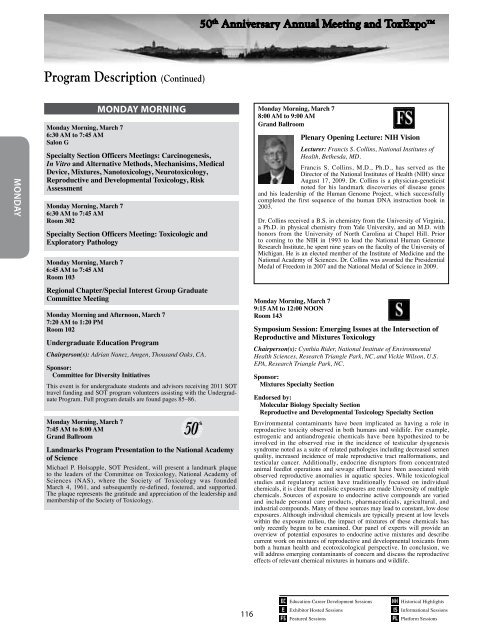Program - Society of Toxicology
Program - Society of Toxicology
Program - Society of Toxicology
Create successful ePaper yourself
Turn your PDF publications into a flip-book with our unique Google optimized e-Paper software.
50 th Anniversary Annual Meeting and ToxExpo<br />
<strong>Program</strong> Description (Continued)<br />
MONday<br />
Abstract # Abstract #<br />
Monday Morning, March 7<br />
6:30 AM to 7:45 AM<br />
Salon G<br />
Monday Morning<br />
Specialty Section Officers Meetings: Carcinogenesis,<br />
In Vitro and Alternative Methods, Mechanisims, Medical<br />
Device, Mixtures, Nanotoxicology, Neurotoxicology,<br />
Reproductive and Developmental <strong>Toxicology</strong>, Risk<br />
Assessment<br />
Monday Morning, March 7<br />
6:30 AM to 7:45 AM<br />
Room 302<br />
Specialty Section Officers Meeting: Toxicologic and<br />
Exploratory Pathology<br />
Monday Morning, March 7<br />
6:45 AM to 7:45 AM<br />
Room 103<br />
Regional Chapter/Special Interest Group Graduate<br />
Committee Meeting<br />
Monday Morning and Afternoon, March 7<br />
7:20 AM to 1:20 PM<br />
Room 102<br />
Undergraduate Education <strong>Program</strong><br />
Chairperson(s): Adrian Nanez, Amgen, Thousand Oaks, CA.<br />
Sponsor:<br />
Committee for Diversity Initiatives<br />
This event is for undergraduate students and advisors receiving 2011 SOT<br />
travel funding and SOT program volunteers assisting with the Undergraduate<br />
<strong>Program</strong>. Full program details are found pages 85–86.<br />
Monday Morning, March 7<br />
7:45 AM to 8:00 AM<br />
Grand Ballroom<br />
Landmarks <strong>Program</strong> Presentation to the National Academy<br />
<strong>of</strong> Science<br />
Michael P. Holsapple, SOT President, will present a landmark plaque<br />
to the leaders <strong>of</strong> the Committee on <strong>Toxicology</strong>, National Academy <strong>of</strong><br />
Sciences (NAS), where the <strong>Society</strong> <strong>of</strong> <strong>Toxicology</strong> was founded<br />
March 4, 1961, and subsequently re-defined, fostered, and supported.<br />
The plaque represents the gratitude and appreciation <strong>of</strong> the leadership and<br />
membership <strong>of</strong> the <strong>Society</strong> <strong>of</strong> <strong>Toxicology</strong>.<br />
Monday Morning, March 7<br />
8:00 AM to 9:00 AM<br />
Grand Ballroom<br />
Plenary Opening Lecture: NIH Vision<br />
Lecturer: Francis S. Collins, National Institutes <strong>of</strong><br />
Health, Bethesda, MD.<br />
Francis S. Collins, M.D., Ph.D., has served as the<br />
Director <strong>of</strong> the National Institutes <strong>of</strong> Health (NIH) since<br />
August 17, 2009. Dr. Collins is a physician-geneticist<br />
noted for his landmark discoveries <strong>of</strong> disease genes<br />
and his leadership <strong>of</strong> the Human Genome Project, which successfully<br />
completed the first sequence <strong>of</strong> the human DNA instruction book in<br />
2003.<br />
Dr. Collins received a B.S. in chemistry from the University <strong>of</strong> Virginia,<br />
a Ph.D. in physical chemistry from Yale University, and an M.D. with<br />
honors from the University <strong>of</strong> North Carolina at Chapel Hill. Prior<br />
to coming to the NIH in 1993 to lead the National Human Genome<br />
Research Institute, he spent nine years on the faculty <strong>of</strong> the University <strong>of</strong><br />
Michigan. He is an elected member <strong>of</strong> the Institute <strong>of</strong> Medicine and the<br />
National Academy <strong>of</strong> Sciences. Dr. Collins was awarded the Presidential<br />
Medal <strong>of</strong> Freedom in 2007 and the National Medal <strong>of</strong> Science in 2009.<br />
Monday Morning, March 7<br />
9:15 AM to 12:00 NOON<br />
Room 143<br />
Symposium Session: Emerging Issues at the Intersection <strong>of</strong><br />
Reproductive and Mixtures <strong>Toxicology</strong><br />
Chairperson(s): Cynthia Rider, National Institute <strong>of</strong> Environmental<br />
Health Sciences, Research Triangle Park, NC, and Vickie Wilson, U.S.<br />
EPA, Research Triangle Park, NC.<br />
Sponsor:<br />
Mixtures Specialty Section<br />
Endorsed by:<br />
Molecular Biology Specialty Section<br />
Reproductive and Developmental <strong>Toxicology</strong> Specialty Section<br />
Environmental contaminants have been implicated as having a role in<br />
reproductive toxicity observed in both humans and wildlife. For example,<br />
estrogenic and antiandrogenic chemicals have been hypothesized to be<br />
involved in the observed rise in the incidence <strong>of</strong> testicular dysgenesis<br />
syndrome noted as a suite <strong>of</strong> related pathologies including decreased semen<br />
quality, increased incidence <strong>of</strong> male reproductive tract malformations, and<br />
testicular cancer. Additionally, endocrine disruptors from concentrated<br />
animal feedlot operations and sewage effluent have been associated with<br />
observed reproductive anomalies in aquatic species. While toxicological<br />
studies and regulatory action have traditionally focused on individual<br />
chemicals, it is clear that realistic exposures are made University <strong>of</strong> multiple<br />
chemicals. Sources <strong>of</strong> exposure to endocrine active compounds are varied<br />
and include personal care products, pharmaceuticals, agricultural, and<br />
industrial compounds. Many <strong>of</strong> these sources may lead to constant, low dose<br />
exposures. Although individual chemicals are typically present at low levels<br />
within the exposure milieu, the impact <strong>of</strong> mixtures <strong>of</strong> these chemicals has<br />
only recently begun to be examined. Our panel <strong>of</strong> experts will provide an<br />
overview <strong>of</strong> potential exposures to endocrine active mixtures and describe<br />
current work on mixtures <strong>of</strong> reproductive and developmental toxicants from<br />
both a human health and ecotoxicological perspective. In conclusion, we<br />
will address emerging contaminants <strong>of</strong> concern and discuss the reproductive<br />
effects <strong>of</strong> relevant chemical mixtures in humans and wildlife.<br />
116<br />
Education-Career Development Sessions<br />
Exhibitor Hosted Sessions<br />
Featured Sessions<br />
Historical Highlights<br />
Informational Sessions<br />
Platform Sessions
















